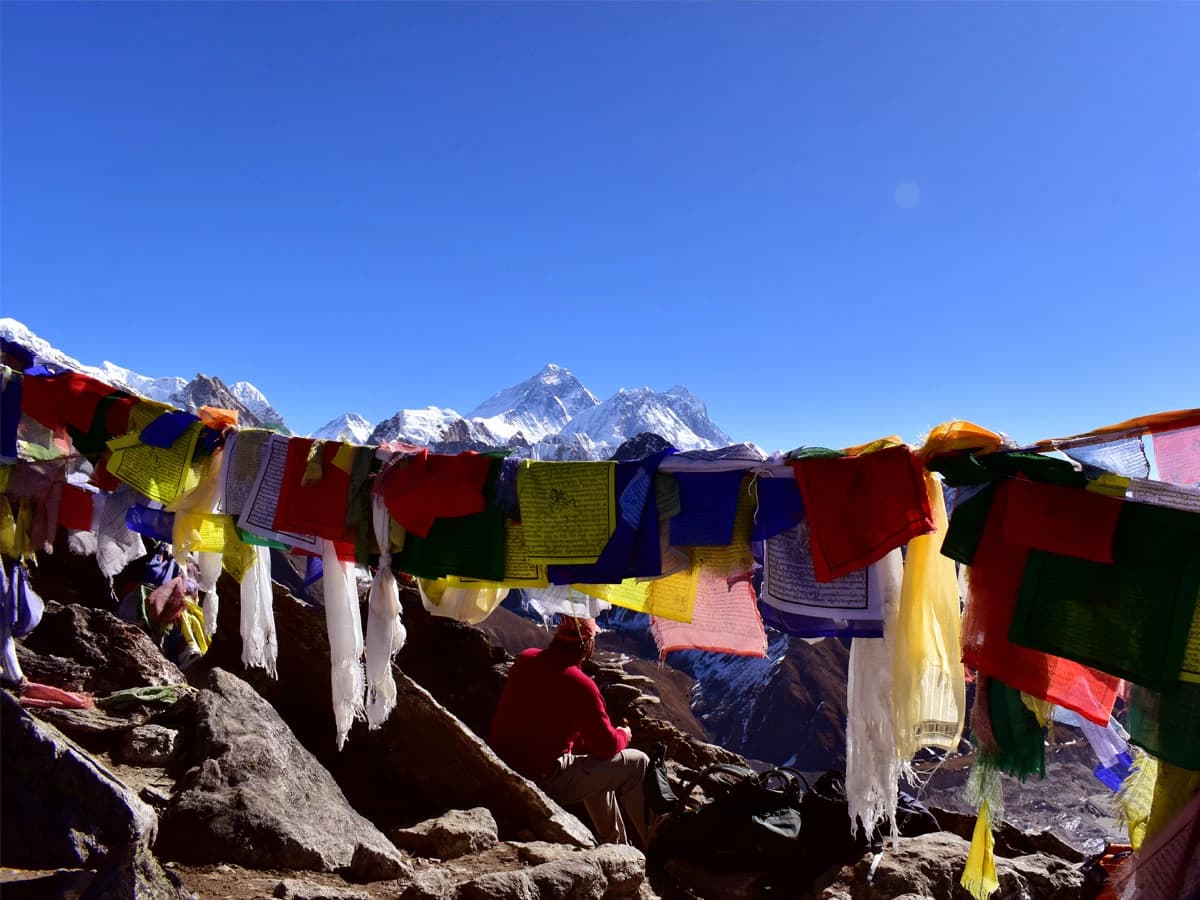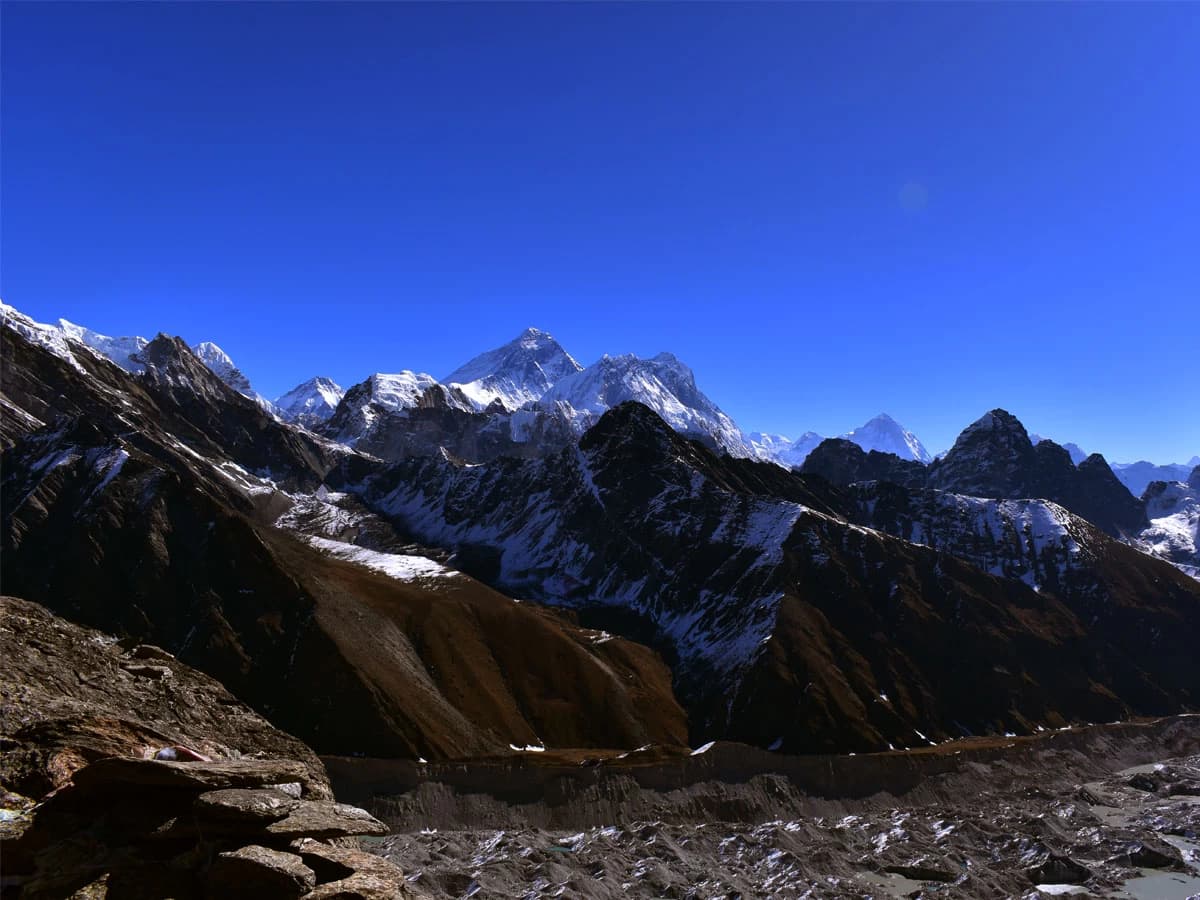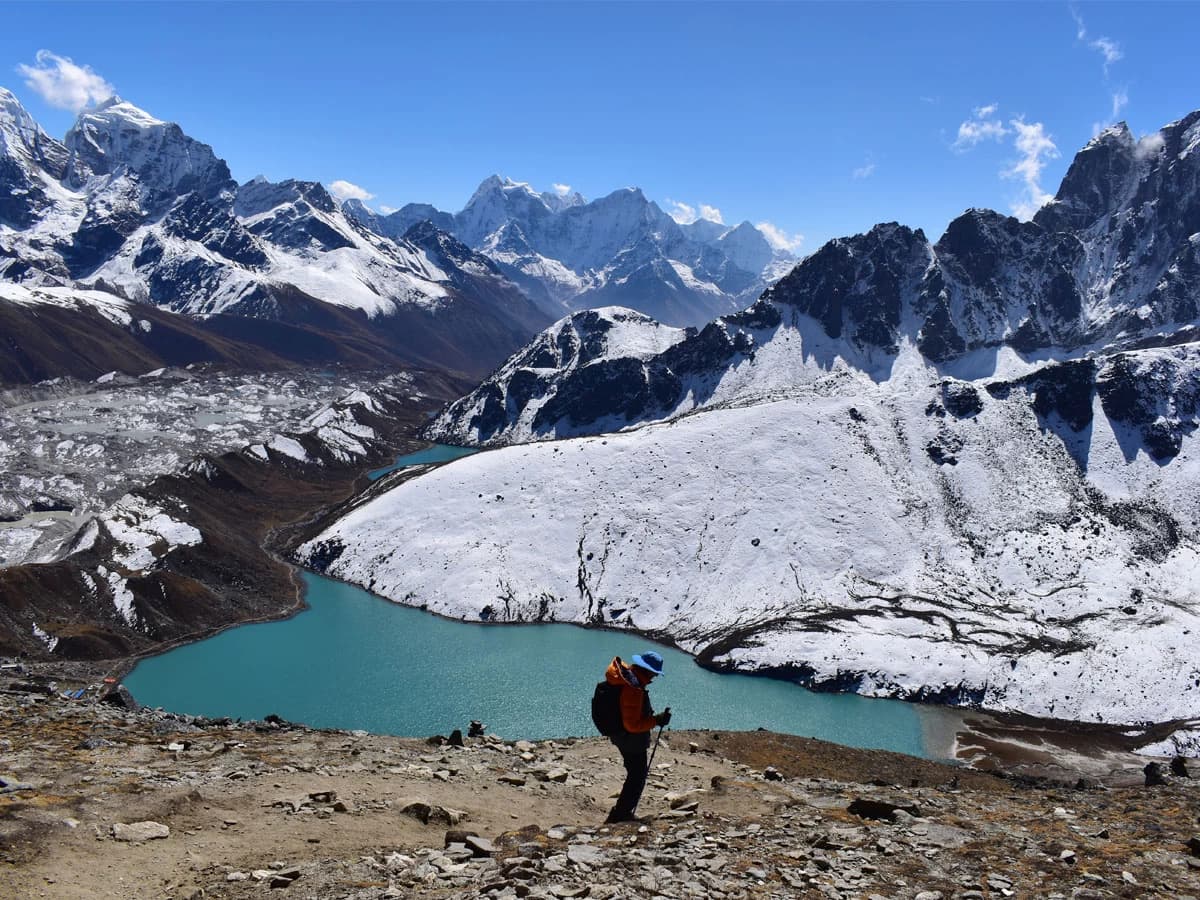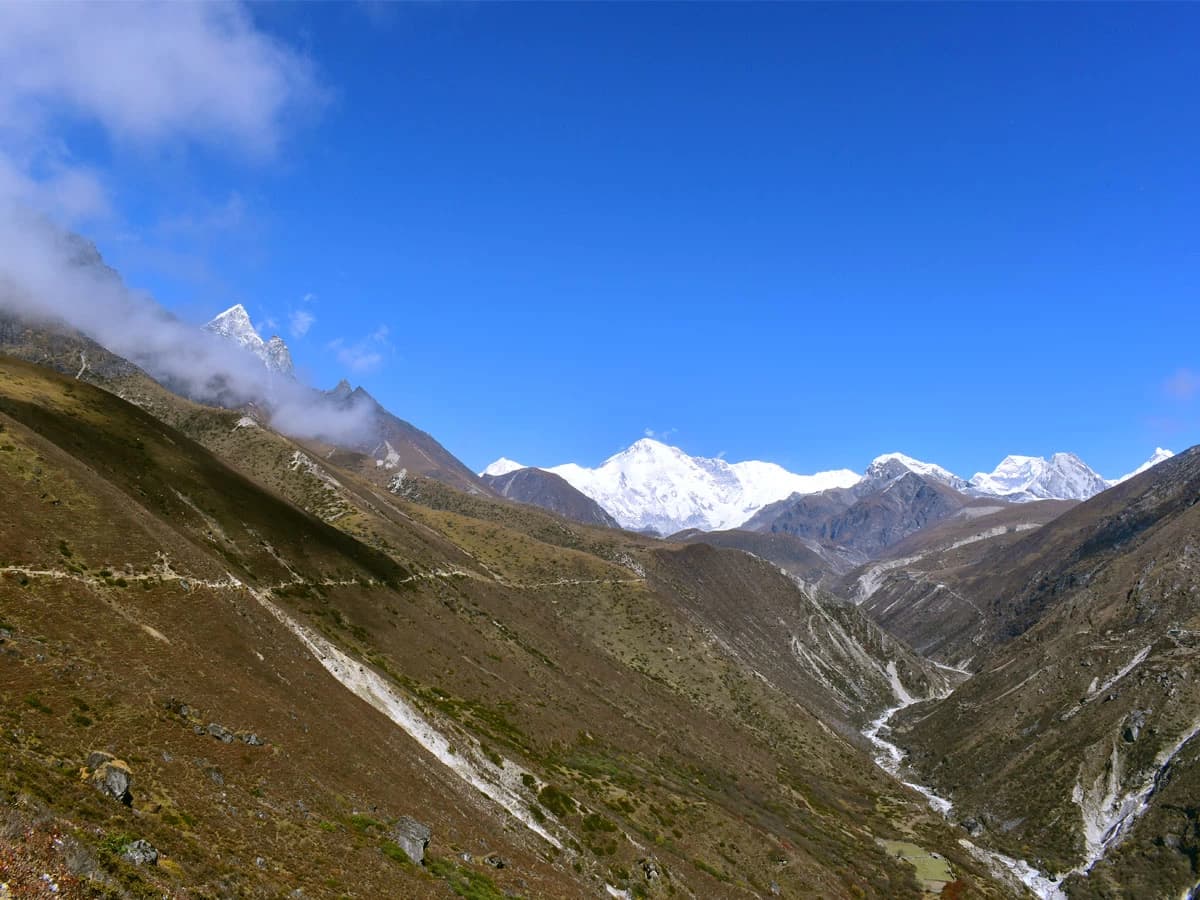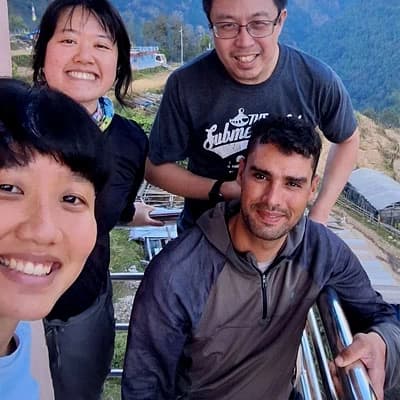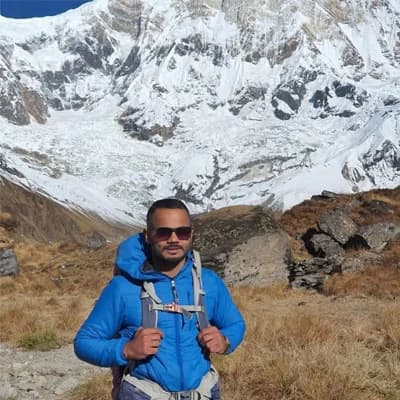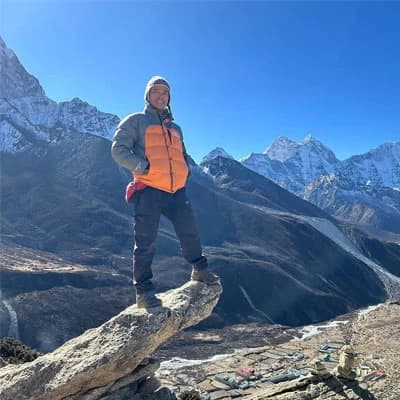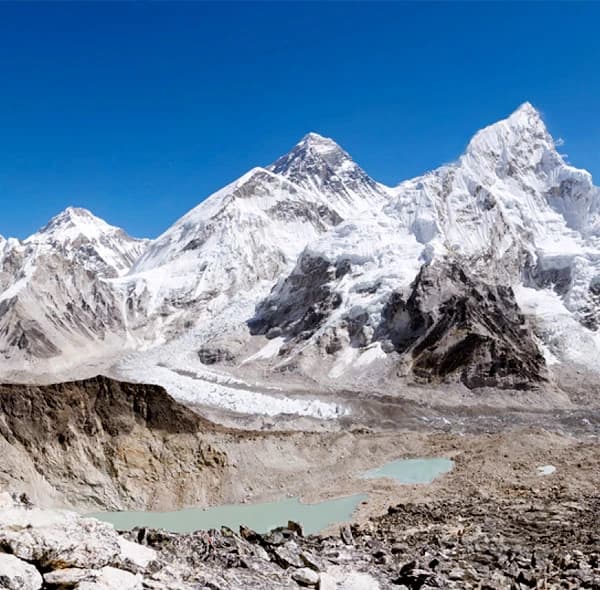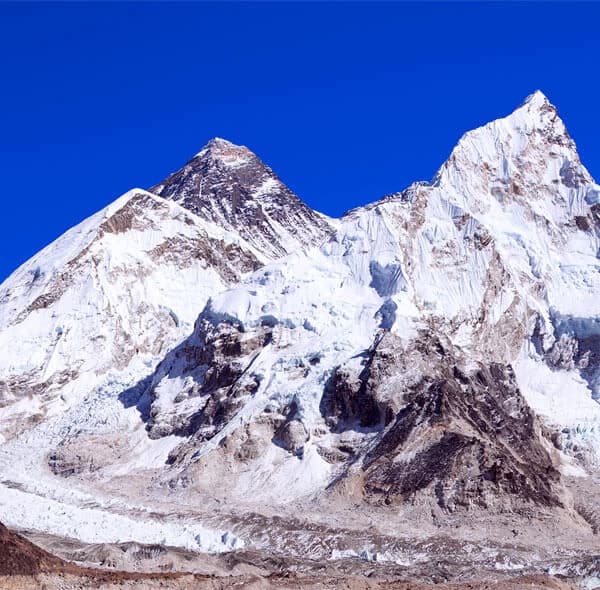The Gokyo Lakes Trek is a 13-day adventure that takes you through the heart of the Himalayas, offering incredible views and cultural experiences. Starting with a scenic flight to Lukla, the trek takes you through charming villages like Phakding and Namche Bazaar. After acclimatizing in Namche, you will continue through Dole and Machhermo to the stunning Gokyo Lakes. A hike to Gokyo Ri (5,357 m) provides unforgettable panoramic views of Everest, Cho Oyu, Lhotse, Makalu, and more. With a visit to the 5th Gokyo Lake adding to the experience, the trek concludes with a descent through Machhermo and Namche, leaving you with lasting memories of this incredible adventure.
Gokyo Lakes Trek
The Gokyo Lake Trek is a spectacular Himalayan adventure that offers stunning mountain views, tranquil lakes, and a unique cultural experience. This Gokyo trekking Adventure takes you through the heart of the Everest region, offering a perfect blend of natural beauty and Sherpa culture. Known for its serene turquoise lakes and dramatic landscapes, the Gokyo Valley Trek is a true highlight for nature lovers and adventure seekers.
Starting with a scenic flight to Lukla, the trek begins with a scenic hike through the villages of Phakding and Namche Bazaar. Namche, a bustling Sherpa town, serves as an ideal spot for acclimatization and offers stunning views of Everest, Lhotse, and Ama Dablam. From here, the trail ascends through Dole and Machhermo, with each day offering increasingly spectacular mountain vistas.
The real highlight of the trek comes when you reach Gokyo on day 7, a peaceful village nestled beside a series of stunning glacial lakes. From here, a hike to Gokyo Ri (5,357 m) rewards you with panoramic views of Everest, Cho Oyu, Lhotse, and Makalu. The beauty of the Gokyo Lakes, with their vibrant blue waters, is truly mesmerizing and offers a serene contrast to the rugged peaks.
There is more than one highlight and things to do on your trek to the Gokyo Lakes. On Day 8, you will hike deeper into the Gokyo Valley, visiting the 4th and 5th Gokyo Lakes. These pristine, turquoise lakes, set against the backdrop of snow-capped peaks, create a truly magical experience. The jaw-dropping scenery and peaceful atmosphere make your day unforgettable.
Similarly, on Day 9, the journey continues with a challenging yet rewarding ascent to Renjo La Pass (5,435 m), one of the best viewpoints in the Everest region. From the top, you will be treated to panoramic views of Everest’s Himalayan peaks and the stunning Rolwaling Valley. This incredible sight marks one of the most spectacular moments of the trek, leaving you with lasting memories of the Himalayan grandeur.
After taking in the awe-inspiring scenery, the trek concludes with a return journey through Machhermo and Namche before flying back to Kathmandu. The Gokyo Lakes Trek is perfect for those seeking a challenging yet rewarding experience, offering incredible mountain views, beautiful lakes, and an authentic taste of Sherpa culture.
It’s an unforgettable journey that allows you to experience the best of Nepal’s natural beauty and Himalayan landscapes.
Highlights
- Trek across the Ngozumpa Glacier, the largest glacier in the Nepalese Himalayas, and experience diverse landscapes, from forests to glaciers.
- Spiritual atmosphere with mani walls, prayer flags, and chortens.
- Visit Tengboche Monastery and experience local Buddhist traditions.
- Hike to the Gokyo 4th and 5th lakes for more spectacular views.
- Trek through the iconic Renjo La Pass.
- Summit Gokyo Ri for panoramic views of Everest, Cho Oyu, and Makalu.
- Trek to the peaceful Gokyo Lakes, a series of six turquoise lakes surrounded by towering peaks.
- Acclimatization and cultural exploration in Namche Bazaar.
- Scenic flight to Lukla with breathtaking Himalayan views
- Flights to and from Lukla operate from Ramechhap during the high season. Usually from 15th March to 15th May and 1st October to 31st November.
- Domestic flight cancel may occur due to the bad weather in Lukla, We suggest you to have one or two days extra to be one safe side.
Gokyo Lakes Trek Itinerary
On Day 1, you will arrive in the vibrant city of Kathmandu, Nepal’s bustling capital. Upon arrival at Tribhuvan International Airport, you will be transferred to your hotel, where you can rest and acclimatize to the city’s unique atmosphere.
The day is free for you to explore the cultural heart of Nepal, with the option to visit iconic landmarks such as Swayambhunath (the Monkey Temple), Boudhanath Stupa, or the ancient temples and bustling streets of Thamel.
After a scenic early morning scenic flight from Kathmandu to Lukla, you will begin your trek toward Phakding. The trail initially descends through lush forests of pine and rhododendrons, crossing suspension bridges over the Dudh Koshi River.
The picturesque Sherpa villages along the way, with stunning views of the surrounding peaks. The trek takes around 3-4 hours, providing a perfect start to the journey, with plenty of time to relax and acclimatize in Phakding.
On Day 3, the trek begins from Phakding to Namche Bazaar, a 5-6 hour hike through beautiful forests and suspension bridges over the Dudh Koshi River. The trail takes you through peaceful woods, with colorful rhododendron flowers and the sound of the river below.
As you climb higher, you will start seeing amazing views of the surrounding mountains, including Mount Everest and Lhotse. The path gradually becomes steeper as you near Namche Bazaar, and the landscape becomes more dramatic, offering panoramic views of the mountains and valleys. Upon arrival in Namche Bazaar, you will be welcomed by this bustling Sherpa town, which sits nestled in the mountains at the base of the impressive peaks.
Namche is a great place to rest and acclimatize, with plenty of opportunities to explore local markets, interact with Sherpa people, and immerse yourself in the region's unique culture. It’s a perfect spot to adjust to the altitude before continuing your trek toward higher elevations.
Day 4 is a key acclimatization day, essential for adjusting to the high altitude of Namche Bazaar. It’s an opportunity to rest, hydrate, and explore the town. Take a short hike to Everest View Hotel for breathtaking views of Mount Everest, Ama Dablam, and Lhotse.
You can also visit the Sherpa Cultural Museum, and the Khunde Monastery, or take a walk to Syangboche for panoramic mountain vistas. This day prepares you for the challenging trek ahead while letting you immerse in the local culture.
On Day 5 of the trek, you will journey from Namche Bazaar to the charming village of Dole, offering a perfect blend of stunning landscapes, cultural immersion, and necessary acclimatization.
Starting the day, you will hike through the scenic Dudh Koshi valley, passing stupas and catching views of iconic peaks like Ama Dablam, Everest, and Thamserku. As the trail splits, take the left path towards the Gokyo Lakes and make your way through pine and rhododendron forests, encountering the picturesque Mong village perched on a ridge.
In the Mong village, be treated to panoramic views of Tengboche and the surrounding area, making it an ideal spot to pause and take in the beauty. Continuing, you will navigate a series of stone stairs, which add a bit of challenge to the day’s trek, before finally reaching Dole at 4,090 meters (13,418 feet).
On Day 6 of your trek, you'll journey from Dole to the tranquil village of Machhermo, a scenic 4-hour trek offering beautiful views and important acclimatization. Leaving Dole, the trail begins with a steep climb through scrub juniper, followed by a gentler uphill gradient for the rest of the way.
As you ascend, the Dudh Koshi River lies far below, and the trail leads you to a ridge above Machhermo, offering stunning vistas of Thamserku. The village is a peaceful stop, providing incredible views of towering peaks like Cho Oyu and Thamserku, making it an ideal spot for rest and reflection.
Machhermo holds cultural significance, with prayer flags, chortens, and Buddhist practices being a part of daily life for the Sherpa people. This village also serves as an essential acclimatization point, featuring a Himalayan Rescue Association (HRA) post that offers advice on altitude sickness and medical assistance.
Day 7 is one of the highlights of the Gokyo Lake trek, as you experience the serene beauty of Gokyo Lake, a system of five glacial lakes set against the majestic backdrop of snow-capped peaks. First, the trek from Machhermo to Gokyo offers scenic beauty and exciting new sights. The trail begins with a climb to a ridge offering stunning views of Kangtega (The Snow Saddle), followed by a narrow valley that opens up into a wider expanse.
The trail is generally not too strenuous, with just a couple of short, steep sections. You will descend to the Dudh Koshi River before embarking on a steep climb to reach the Ngozumpa Glacier and the first of the Gokyo Lakes.
As you continue north, you will encounter the second Gokyo Lake, which is longer and more expansive than the first and runs parallel to the trail. Further along, you will reach the third lake and several teahouses, where you can stop for lunch. Afterward, you will hike up to Gokyo Ri, a challenging 2.5 to 3-hour climb.
The Gokyo Ri trek at 5,357 meters offers one of the best panoramic views in the region, with towering mountains above and lakes and glaciers below. The sunset from this viewpoint is spectacular and highly recommended.
Gokyo Village is the last stop on the Gokyo Lakes Trek. But the real highlights come after - climbing Gokyo Ri (5,357m) and visiting the 4th and 5th Gokyo Lakes.
Early in the morning, you'll hike up to Gokyo Ri to watch a breathtaking sunrise. From the top, you can see a stunning view of famous mountains like Everest, Makalu, Cho Oyu, Nuptse, Pumori, Amadablam, Cholatse, and Kwangde. Because of this, some people also call this journey the Gokyo Ri Trek.
After returning to Gokyo Village for lunch, you'll continue your adventure by hiking to the 4th and 5th Gokyo Lakes, which are about 2 miles north of the village.
Today, you will trek to Renjo La Pass (5,435m), one of the high passes in the Everest region. The trail starts with a steep climb before leveling out for a while. After that, you will continue on a gentle uphill path. In the distance, colorful prayer flags will signal your arrival at the pass.
Just before reaching Renjo La Pass, you will take on another steep climb. From the top, you will be rewarded with breathtaking views of Mt. Makalu, Tengi Ragi Tau, the Rolwaling Range, and Gyachung Kang. After soaking in the scenery, you will descend towards Lungden, where you will enjoy a warm dinner and rest for the night.
On this day, you will leave Lungden and begin your trek toward Thame, the village where Tenzing Norgay grew up. The trail first takes you through a narrow valley and across Marulung. From there, you will descend along the path through Tangga.
As you keep walking, you will pass through beautiful forests filled with rhododendrons and pine trees. The hike to Namche Bazaar is not too hard, with no big climbs or steep descents. After a few hours, you will arrive in Namche, where you can rest and enjoy the evening.
Day 11 marks the final trekking day of the Gokyo Trekking Adventure. The descent from Namche Bazaar to Lukla is steady, with a mix of gentle trails and steeper sections, eventually leading to the Dudh Koshi River. Along the way, you will cross several suspension bridges, walk past monasteries, and enjoy views of the surrounding mountains for one last time.
Arriving in Lukla, you will have the chance to reflect on your incredible journey, celebrate your accomplishments with fellow trekkers, and enjoy a relaxing evening in this bustling gateway village. This final leg of the trek is a blend of nostalgia and excitement, as you complete your adventure through the breathtaking landscapes of the Khumbu region.
You will take an early morning flight from Lukla to Kathmandu, enjoying the scenic views once again. Since the weather in the Himalayas can be unpredictable, flight delays are possible, so be prepared for any schedule changes.
After arriving in Kathmandu, you will have the rest of the day to explore. You may roam around the streets of Thamel, shop for souvenirs, or relax at a spa. In the evening, you will enjoy a special farewell dinner to celebrate the end of your journey.
We will accompany you to the airport for your departure. If you're staying longer in Nepal, we wish you a wonderful continuation of your travels and can assist in arranging your next adventure here!
Gokyo Lakes Trek Route Map
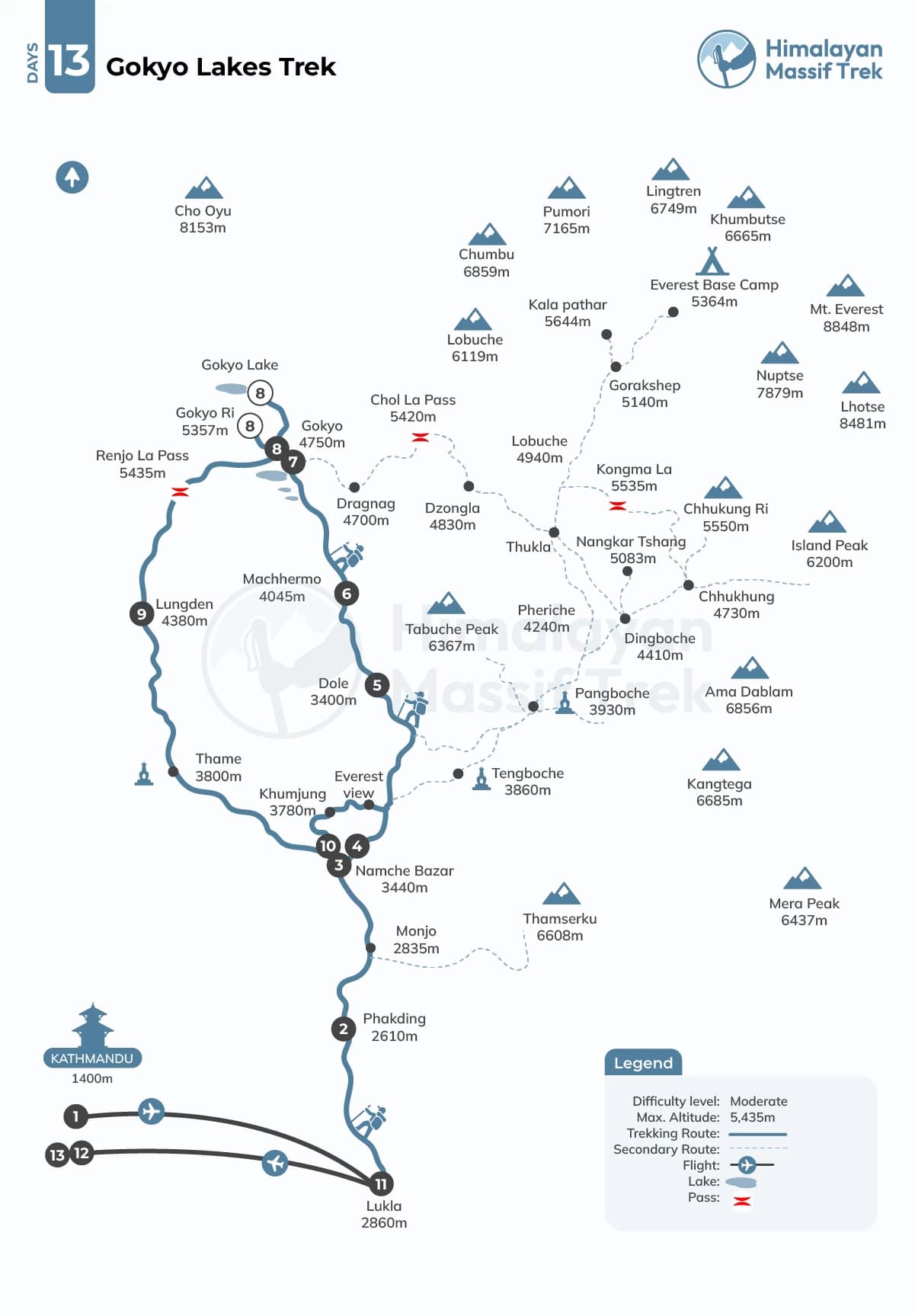

Cost Details
- Airport transfers
- 12 Breakfasts, 10 Lunches, 10 Dinners
- 3-Star accommodation in Kathmandu for 2 nights
- Tea house accommodation along the way for 10 nights
- All land transportation with pickups and drops
- Domestic Flight to Lukla and return to Kathmandu
- Professional trekking guide and porter ( 1 porter between 2 trekkers)
- Sagarmatha National Park Entrance Fee
- Local government tax
- Down jacket, a Sleeping to use for the trekking
- Necessary paperwork with the government of Nepal and the Tax department
- First Aid service in case of minor injuries
- Salary, food, and accommodation for guides and porters
- Lunch and dinners in Kathmandu
- Emergency evacuation and travel insurance
- Extra night accommodation in Kathmandu due to early arrival and late departure
- Personal expenses (phone calls, internet, laundry, bar bills, battery recharge, extra porters, cold drinks, bottled or boiled water, hot shower, etc.)
- All the alcoholic and non-alcoholic beverages
- Nepal entry visa fee
- Tipping for guide and porter
To confirm your payment, a deposit payment is required, which is 30% of the total booking price. This deposit helps us secure permits, logistics, and other necessary arrangements for your trek.
We understand that plans can change, and we strive to be as flexible as possible. However, to cover operational costs, a cancellation fee applies. This is a percentage of your total booking price and is deducted from the deposit payment.
Cancellation Fees
Cancel 30% days before departure: 5% of the trip cost
Cancel between 10 to 30 days before departure: 10% of the trip cost
Cancel within 10 days of departure: 20% of the trip cost
If you need to cancel, please notify us as early as possible to reduce charges.
Rescheduling
Unexpected circumstances can disrupt travel plans, even if you still want to do the trip. To support our clients, we have generously waived all rescheduling fees. You can postpone and reschedule your trip at no additional cost, as long as the new departure date falls within one year of your original booking.
Upgrades
If you wish to upgrade your accommodation, transportation, or any other services not mentioned in the Trip Includes section, please be aware that these upgrades will incur additional costs. We can assist in arranging these options for you based on your preferences and availability.
Lukla Flights
Non-Refundable Flight Ticket: If you need helicopter evacuation or other means of transport due to altitude sickness or any other condition, your return flight ticket fare is non-refundable.
Refundable Flight Ticket: If the flight operator cancels your flight due to bad weather in Lukla, Kathmandu, or any other reason, your flight ticket fare is 100% refundable.
Dates & Availability
Private TripGroup price is applied for private trips and when you book a trip together as a team. Trip departure is guaranteed once you book the trip with HMT. If you don't find an appropriate date, you can propose a Preferred Departure Date, and we’ll ensure the trip runs as scheduled just for you.
Trip Gallery
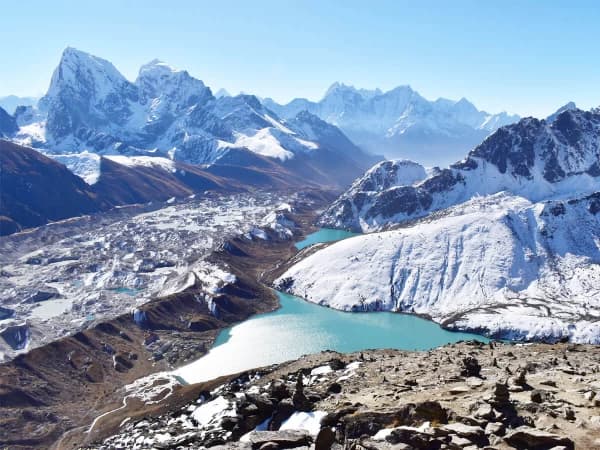
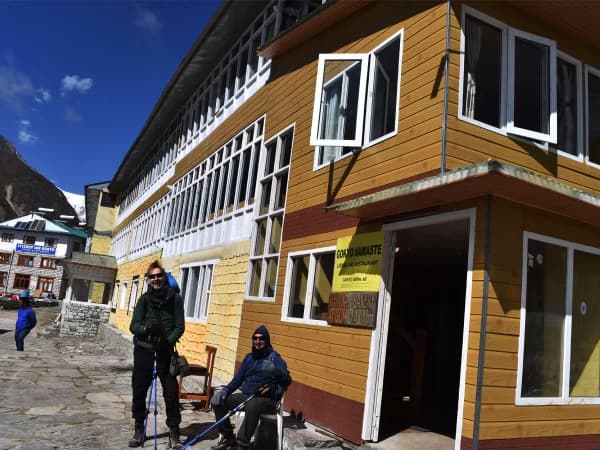
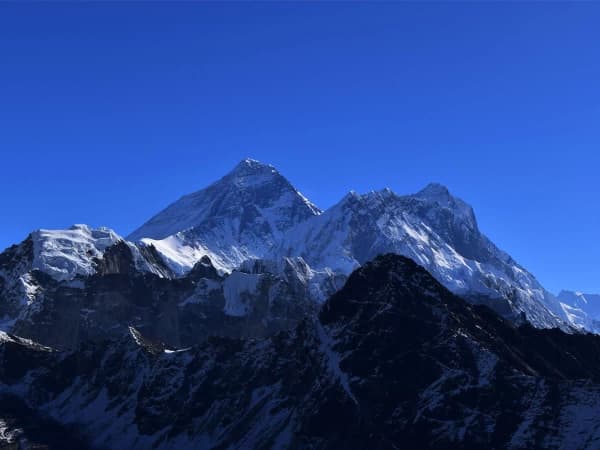

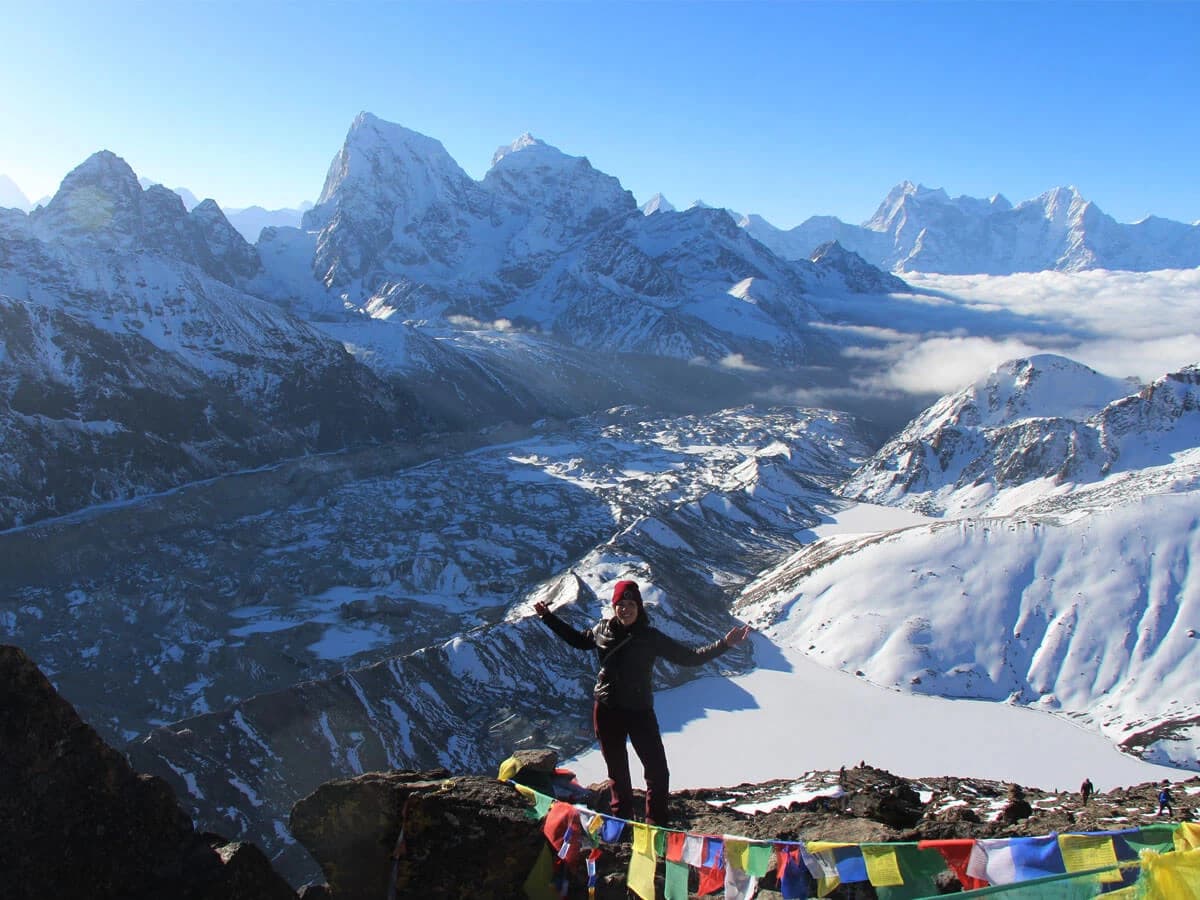
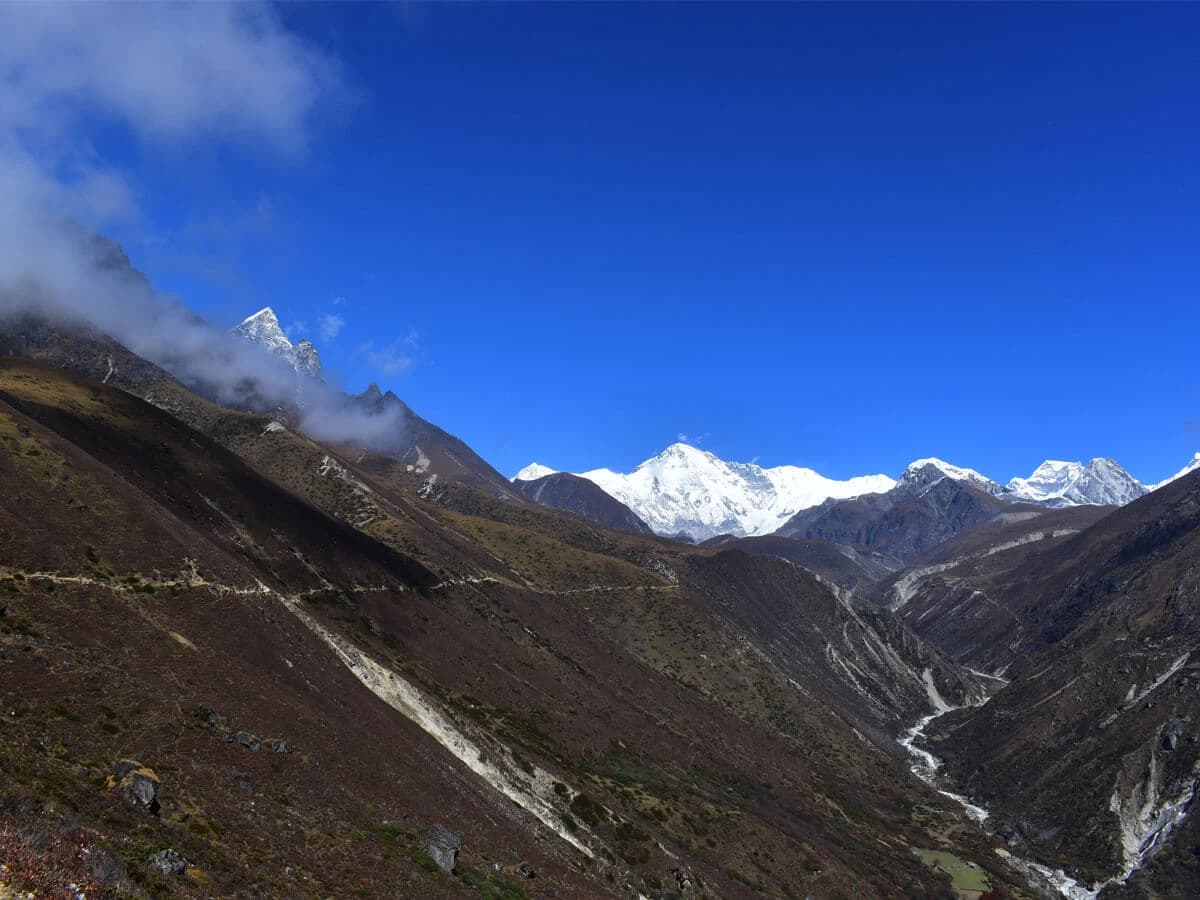
Essential Information
Accommodation Details
Accommodation on the Gokyo Lakes Trek primarily consists of tea houses and lodges, providing trekkers with a comfortable place to rest after a day of hiking. In the lower villages like Lukla and Namche Bazaar, you will find basic but cozy rooms with essential amenities, including beds, blankets, and shared bathrooms.
As you ascend to higher altitudes, accommodations become more basic, with rooms often offering simple wooden beds and minimal heating. In places like Dole, Machhermo, and Gokyo, tea houses provide hearty meals and warm drinks, which are essential for acclimatization.
Bathrooms are typically shared, and hot water may not always be available, especially at higher elevations. Despite the simplicity, these lodges offer a warm, welcoming atmosphere and a chance to interact with fellow trekkers and local Sherpa families.
It’s recommended to book in advance during peak seasons, but during quieter months, accommodations are usually available on a first-come, first-served basis.
Altitude Considerations
The Gokyo Lakes Trek takes trekkers to high altitudes, with the trek reaching up to Gokyo Ri at 5,357 meters (17,575 feet). As you ascend, it is important to be aware of altitude-related issues, particularly altitude sickness.
To minimize risks, the trek includes built-in acclimatization days, such as the day spent in Namche Bazaar (3,438 m) and another at Machhermo (4,470 m). These stops help your body adjust to the decreasing oxygen levels, which is crucial for a safe and enjoyable experience.
It’s important to stay hydrated, eat well, and take it slow, especially on the steeper sections of the trek. Symptoms of altitude sickness include headaches, dizziness, and nausea, so it’s essential to listen to your body and rest if needed.
For those planning to hike to the 4th Gokyo Lake or beyond, be prepared for even higher elevations and consider extra acclimatization if needed. Trekkers should always descend to a lower altitude if symptoms of altitude sickness become severe.
Permits and Regulations
To trek the Gokyo Lakes, you will need to obtain a few essential permits. These are required for trekking in the Everest region and ensure that trekkers comply with local regulations designed to protect the environment and local culture.
TIMS (Trekkers’ Information Management System) Card
This card is mandatory for all trekkers in Nepal. It helps authorities track trekkers and ensure safety. The TIMS card is obtained through a licensed trekking agency, and its cost varies depending on whether you are trekking as an individual or in a group.
Sagarmatha National Park Permit
The Gokyo Lakes Trek passes through the Sagarmatha National Park, home to Mount Everest and other notable peaks. A permit is required to enter the park, and it can be obtained in Kathmandu or at the entrance point of the park in Monjo. The fee is typically around USD 30 (subject to change), and the permit helps support conservation efforts in the region.
Khumbu Pasang Lhamu Rural Municipality Permit
This permit is also required for trekkers traveling through the Khumbu region. It helps support the local communities and the preservation of the area. The fee is usually around USD 20 and USD 10 for SAARC nationals. Permits can be obtained along with the Sagarmatha National Park permit.
Tips for Trekkers
Carry Your Permits: Always have your permits with you as they will be checked at various checkpoints along the trek.
Trek with a Licensed Guide or Porter: If you're unfamiliar with the region, hire a licensed guide or porter to help with permits and ensure a safe trek.
Follow Local Regulations: Adhere strictly to local regulations to protect the environment and cultural heritage of the Gokyo Lakes.
Respect the Environment and Communities: Dispose of waste properly and respect local customs to help preserve the natural beauty of the area.
Travel Insurance Guidance
When preparing for the Gokyo Lakes Trek, securing the right travel insurance is a must. Trekking at high altitudes, reaching up to 5,357 meters (17,575 feet) at Gokyo Ri, means you need insurance that specifically covers high-altitude trekking. Many standard policies do not cover activities at these altitudes, so check that this is explicitly included.
In case of an emergency, evacuation by helicopter or other means is essential, as the remote location can make access to medical help difficult. It’s also vital that your policy includes coverage for medical treatment in case of altitude sickness or injuries, as well as protection for trip cancellations and any unexpected delays.
Finally, coverage for lost or damaged gear will give you peace of mind.
Best Time to Trek
The best time to trek the Gokyo Lakes is during the spring (March to May) and autumn (September to November) seasons.
Spring is one of the most popular times for trekking. During this period, the weather is stable with moderate temperatures and clear skies. The rhododendrons along the trail bloom in full force, adding vibrant colors to the landscape. The crisp air provides excellent visibility, making it the perfect time for trekking with stunning views of the Himalayan peaks, including Everest, Cho Oyu, and Makalu.
Autumn is another prime trekking season. After the monsoon rains have passed, the trails are dry and easy to navigate. The skies are clear, offering fantastic mountain vistas. The landscapes are lush and green from the rains, and the weather is stable, making it an ideal time for those looking to enjoy the tranquility of the Gokyo Lakes and the surrounding mountains.
On the other hand, Winter (December to February) and Summer/Monsoon (June to August) are generally not recommended for trekking. Winter in the Everest region can be extremely cold, especially at higher altitudes, with heavy snowfalls making the trek challenging and risky. The monsoon season brings heavy rains, which can make the trails slippery, increase the risk of landslides, and lead to poor visibility.
Understanding these weather patterns helps trekkers choose the best time for their adventure and be prepared for any challenges along the way.
The table below provides a more detailed breakdown of weather expectations for each season.
|
Season |
Temperature (Day) |
Temperature (Night) |
Weather Conditions |
Best for Trekking |
|
Spring (March to May) |
10°C to 20°C (50°F to 68°F) |
-5°C to -10°C (23°F to 14°F) |
Clear skies, mild weather, blooming rhododendrons. |
Yes, Ideal Trekking Season |
|
Autumn (September to November) |
10°C to 20°C (50°F to 68°F) |
-5°C to -10°C (23°F to 14°F) |
Stable weather, clear skies, excellent visibility. |
Yes, Ideal Trekking Season |
|
Winter (December to February) |
-5°C to 5°C (23°F to 41°F) |
-15°C to -20°C (5°F to -4°F) |
Extremely cold, heavy snowfall above 4,000m, freezing temperatures. |
Not Recommended (Very Cold) |
|
Monsoon/Summer (June to August) |
15°C to 25°C (59°F to 77°F) |
5°C to 10°C (41°F to 50°F) |
Frequent rain, slippery trails, poor visibility, risk of landslides. |
Not Recommended (Rainy) |
Gokyo Lakes Trek Equipment List
FAQs
The Gokyo Lakes Trek typically takes around 12 days, including the flight from Kathmandu to Lukla and rest days for acclimatization. The trek itself covers approximately 60-75 kilometers (37-46 miles), depending on your route and pace. This includes treks through the Khumbu region, with multiple stops at villages like Namche Bazaar and Machhermo.
The Gokyo Lakes offer a range of activities for trekkers, including exploring the six stunning turquoise lakes, hiking to Gokyo Ri for panoramic mountain views, and immersing in the tranquil surroundings. You can also take an optional hike to the Fourth Gokyo Lake and experience the pristine wilderness, or visit local villages to learn about the unique culture of the Sherpa and Tibetan communities.
From Gokyo Ri, trekkers are treated to breathtaking views of some of the world’s highest peaks, including Mount Everest, Makalu, Cho Oyu, Lhotse, Nuptse, and Manaslu. The Gokyo valley and the panoramic views from Gokyo Ri (5,357 meters/17,575 feet) are a highlight of the trek, offering a unique perspective of the Himalayas.
To reach Gokyo Lake, fly from Kathmandu to Lukla, a small mountain airstrip in the Khumbu region. From Lukla, you will trek through Phakding, Namche Bazaar, Dole, and Machhermo before reaching Gokyo Lakes. The trek is well-marked and passes through stunning landscapes, including dense forests, alpine meadows, and Sherpa villages.
You will need a Trekking Information Management System (TIMS) card and a Sagarmatha National Park permit to trek in the Everest region. These can be obtained in Kathmandu or at the entry points during the trek.
Essential items to pack include layers for warmth, waterproof clothing, trekking boots, a sleeping bag, a headlamp, sunscreen, and medications. Don’t forget your water bottle, and ensure you have enough snacks for the trek.
The Gokyo Lakes Trek is considered a moderate to challenging trek, requiring a good level of fitness and some previous trekking experience. The trail involves steep ascents, high altitudes, and long days of walking, but it’s achievable for those in good health.
Accommodation along the Gokyo Lakes Trek is typically in teahouses, which offer basic rooms with shared facilities. The higher you go, the more basic the accommodations, but they provide a warm and comfortable place to rest after a day's trekking.
Yes, altitude sickness can be a risk due to the high elevation of Gokyo Ri and surrounding areas. It’s important to acclimatize properly by taking rest days and ascending gradually. Drink plenty of water, avoid alcohol, and consult a doctor before the trek if you have concerns.
I. Expertise and Local Knowledge
When you book the trek with Himalayan Massif Trek, you're choosing a team of experienced guides who have in-depth knowledge of the Everest region. The guides are locals who know the culture, terrain, and trails better than anyone else. With decades of trekking expertise in the Himalayan belt, they will ensure you have a safe and enriching journey throughout your trek.
II. Authentic Local Experiences
We offer you the chance to experience authentic Sherpa villages like Namche, Dole, and Machhermo. Along the way, you'll enjoy traditional Sherpa meals, providing you with a true taste of local culture. You’ll also gain insights into the traditions, lifestyle, and hospitality of the people from the Everest region. Hence, this makes your trek feel like more than just a hike - it’s a cultural adventure.
III. Value for Money
Great value for money is another reason you should book your Gokyo Lakes Trek with Himalayan Massif Trek. We offer competitive prices with no hidden costs. Everything is included, from your permits and comfortable accommodations to your delicious meals. Plus, we have special discounts for groups and repeat travellers.
IV. Environmental Responsibility
Our company is committed to environmental responsibility, ensuring that trekking in the Everest region has minimal impact on the environment. By using eco-friendly trekking practices and supporting local suppliers, we help preserve the beauty of the Himalayas. We also, prioritize sustainable travel, assuring that local communities and the stunning landscape remain protected for future generations.
- Expertise in High-Altitude Trekking Adventures
- Over 18 Years of Experience in The Himalayas
- Authorized and Reliable Trekking Partner
- Trusted by Thousands of Adventurers Worldwide
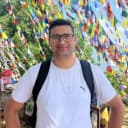
This trek was a perfect blend of adventure and tranquility. The Gokyo Lakes were serene, and the hike up Gokyo Ri offered panoramic views of...
The Gokyo Lakes Trek was absolutely stunning. The turquoise lakes and the views of Everest from Gokyo Ri were breathtaking. The team at Himalayan Massif...
The Gokyo Lakes Trek was a hidden gem. The trails were less crowded, and the scenery was just as spectacular as EBC. The team was...

